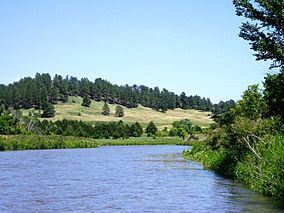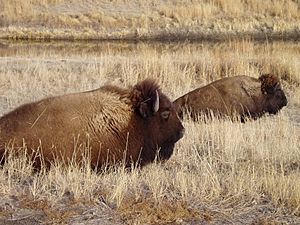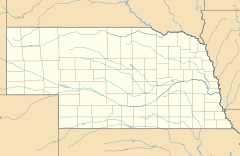Niobrara Valley Preserve facts for kids
Quick facts for kids Niobrara Valley Preserve |
|
|---|---|

The Niobrara River runs through a pine-forested valley with prairies in the uplands.
|
|
| Location | Brown Cherry and Keya Paha counties, Nebraska |
| Nearest city | Valentine |
| Area | 56,000 acres (23,000 ha) |
| Established | 1980 |
| Governing body | The Nature Conservancy |
The Niobrara Valley Preserve is a huge natural area in Nebraska. It covers about 56,000 acres (that's like 42,000 football fields!). This special place is owned by The Nature Conservancy, a group that works to protect important natural lands and waters. It's a fantastic spot for nature lovers and adventurers.
Contents
History of the Niobrara Valley Preserve
Before settlers from Europe arrived, large herds of bison and other prairie animals roamed the Niobrara River valley. In the 1800s, the Ponca Native Americans lived near the river's mouth. Nomadic tribes like the Lakota (also called Sioux) traveled across the rest of the land.
In the 1870s, ranchers started bringing cattle to graze here. Then, in the 1880s, families began to start small farms and ranches. However, much of the Niobrara Valley wasn't good for farming. Many farmers soon left. By the 1900s, the land was mostly used for large cattle ranches. Because less farming happened, the number of people living in Brown and Keya Paha counties dropped a lot between 1890 and 2010.
The Nature Conservancy bought the Preserve in 1980. It's located within the western part of the 76-mile-long Niobrara National Scenic River. This river is managed by the National Park Service.
Exploring the Niobrara Valley Preserve

The Niobrara Valley Preserve is one of the biggest protected areas in the Great Plains. It protects 25 miles of the river's south bank and 8.5 miles of its north bank. On the north side, steep hills and bluffs rise up to 400 feet above the river. The unique Sand Hills are found near the river on its south bank.
A Mix of Nature: "Biological Crossroads"
The Preserve is like a "biological crossroads" because six different types of natural environments meet here. You can find northern forests, western pine forests, eastern leafy forests, and three kinds of prairies (mixed grass, tallgrass, and sandhills prairie). This mix means many different plants and animals can live here.
Over 580 types of plants, 213 kinds of birds, and 85 types of butterflies call the Preserve home. Some special trees include the Ponderosa Pine, which is at the very eastern edge of where it usually grows. You can also find a mix of Quaking and Bigtooth Aspen trees, and Paper Birch trees, which usually grow in colder, more northern places.
Bringing Back the Bison
In 1985, The Nature Conservancy brought bison back to the Preserve. They had been gone for over 100 years! Now, more than 500 bison graze in two large pastures. These pastures are 7,500 and 12,000 acres big.
The Conservancy also leases 27,000 acres to local ranchers, where about 2,000 cattle graze. They use controlled burning as a tool to help manage the land. This prevents unwanted plants from taking over the prairies and forests. The main goal is to bring back the natural landscape that existed long ago.
The Conservancy also works with local ranchers to protect more land. They make agreements called "scenic easements." These agreements help keep the land from being developed or divided into smaller pieces.
Fun Activities at the Preserve
The Niobrara Valley Preserve has a visitor's center where you can learn about the area's history and nature. You can also arrange tours to see the bison up close!
There are two hiking trails near the visitor's center. One is on the north side of the river, and the other is on the south side. The north trail is about three miles long and follows the canyon rim, giving you amazing views of the river. If you enjoy hunting, you can hunt for deer and turkey on the Preserve.
Floating the Niobrara River
Floating down the 76-mile scenic river is a very popular summer activity. Part of this river runs right through the Preserve. The water is usually deep enough for canoes and kayaks. You can find places nearby that rent canoes and kayaks.
The Niobrara River is beautiful, with clear, clean water. It even has some small rapids (Class I and II), which makes it exciting! You'll also see waterfalls in many side canyons where streams flow down into the valley. In 2010, about 50,000 people floated the Niobrara River. This brought about $10 million to the local economy!


